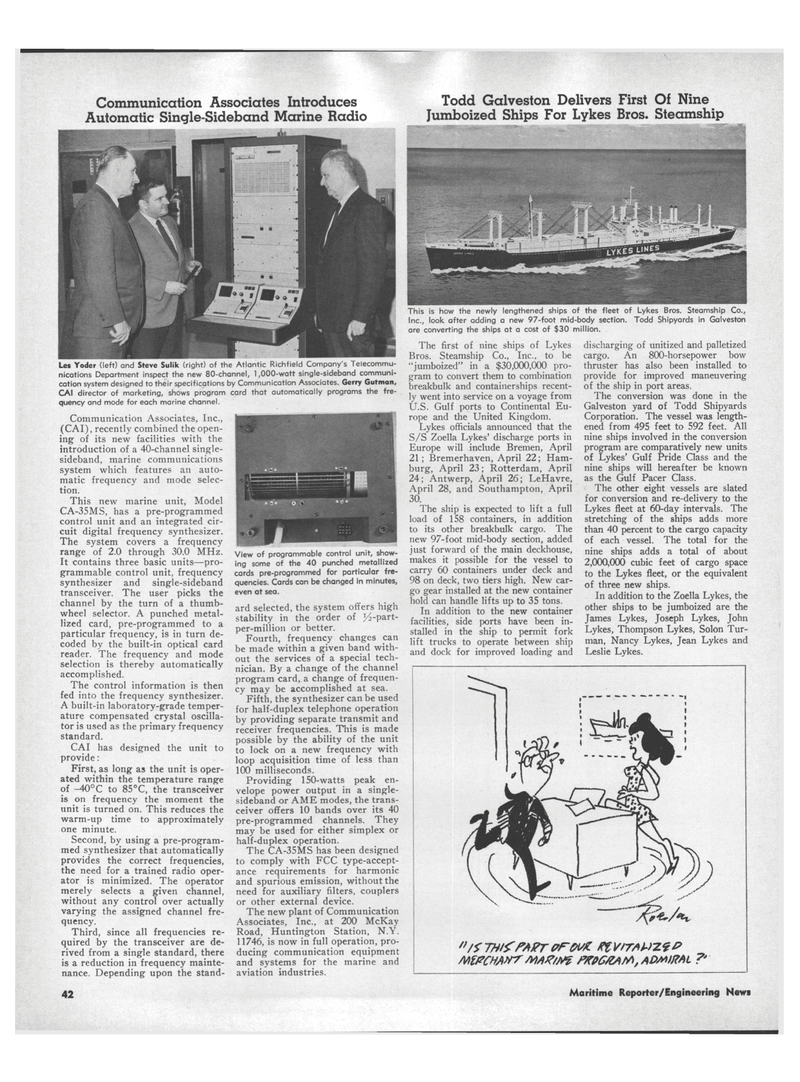
Page 40: of Maritime Reporter Magazine (April 15, 1971)
Read this page in Pdf, Flash or Html5 edition of April 15, 1971 Maritime Reporter Magazine
Communication Associates Introduces
Automatic Single-Sideband Marine Radio
Todd Galveston Delivers First Of Nine
Jumboized Ships For Lykes Bros. Steamship •
Les Yoder (left) and Steve Sulik (right) of the Atlantic Richfield Company's Telecommu- nications Department inspect the new 80-channel, 1,000-watt single-sideband communi- cation system designed to their specifications by Communication Associates. Gerry Gutman,
CAI director of marketing, shows program card that automatically programs the fre- quency and mode for each marine channel.
Communication Associates, Inc., (CAI), recently combined the open- ing of its new facilities with the introduction of a 40-channel single- sideband, marine communications system which features an auto- matic frequency and mode selec- tion.
This new marine unit, Model
CA-35MS, has a pre-programmed control unit and an integrated cir- cuit digital frequency synthesizer.
The system covers a frequency range of 2.0 through 30.0 MHz.
It contains three basic units—pro- grammable control unit, frequency synthesizer and single-sideband transceiver. The user picks the channel by the turn of a thumb- wheel selector. A punched metal- lized card, pre-programmed to a particular frequency, is in turn de- coded by the built-in optical card reader. The frequency and mode selection is thereby automatically accomplished.
The control information is then fed into the frequency synthesizer.
A built-in laboratory-grade temper- ature compensated crystal oscilla- tor is used as the primary frequency standard.
CAI has designed the unit to provide:
First, as long as the unit is oper- ated within the temperature range of -40°C to 85°C, the transceiver is on frequency the moment the unit is turned on. This reduces the warm-up time to approximately one minute.
Second, by using a pre-program- med synthesizer that automatically provides the correct frequencies, the need for a trained radio oper- ator is minimized. The operator merely selects a given channel, without any control over actually varying the assigned channel fre- quency.
Third, since all frequencies re- quired by the transceiver are de- rived from a single standard, there is a reduction in frequency mainte- nance. Depending upon the stand-
This is how the newly lengthened ships of the fleet of Lykes Bros. Steamship Co.,
Inc., look after adding a new 97-foot mid-body section. Todd Shipyards in Galveston are converting the ships at a cost of $30 million.
View of programmable control unit, show- ing some of the 40 punched metallized cards pre-programmed for particular fre- quencies. Cards can be changed in minutes, even at sea. ard selected, the system offers high stability in the order of ^-part- per-million or better.
Fourth, frequency changes can be made within a given band with- out the services of a special tech- nician. By a change of the channel program card, a change of frequen- cy may be accomplished at sea.
Fifth, the synthesizer can be used for half-duplex telephone operation by providing separate transmit and receiver frequencies. This is made possible by the ability of the unit to lock on a new frequency with loop acquisition time of less than 100 milliseconds.
Providing ISO-watts peak en- velope power output in a single- sideband or AME modes, the trans- ceiver offers 10 bands over its 40 pre-programmed channels. They may be used for either simplex or half-duplex operation.
The CA-35MS has been designed to comply with FCC type-accept- ance requirements for harmonic and spurious emission, without the need for auxiliary filters, couplers or other external device.
The new plant of Communication
Associates, Inc., at 200 McKay
Road, Huntington Station, N.Y. 11746, is now in full operation, pro- ducing communication equipment and systems for the marine and aviation industries.
The first of nine ships of Lykes
Bros. Steamship Co., Inc., to be "jumboized" in a $30,000,000 pro- gram to convert them to combination breakbulk and containerships recent- ly went into service on a voyage from
U.S. Gulf ports to Continental Eu- rope and the United Kingdom.
Lykes officials announced that the
S/S Zoella Lykes' discharge ports in
Europe will include Bremen, April 21; Bremerhaven, April 22; Ham- burg, April 23; Rotterdam, April 24; Antwerp, April 26; LeHavre,
April 28, and Southampton, April 30.
The ship is expected to lift a full load of 158 containers, in addition to its other breakbulk cargo. The new 97-foot mid-body section, added just forward of the main deckhouse, makes it possible for the vessel to carry 60 containers under deck and 98 on deck, two tiers high. New car- go gear installed at the new container hold can handle lifts up to 35 tons.
In addition to the new container facilities, side ports have been in- stalled in the ship to permit fork lift trucks to operate between ship and dock for improved loading and discharging of unitized and palletized cargo. An 800-horsepower bow thruster has also been installed to provide for improved maneuvering of the ship in port areas.
The conversion was done in the
Galveston yard of Todd Shipyards
Corporation. The vessel was length- ened from 495 feet to 592 feet. All nine ships involved in the conversion program are comparatively new units of Lykes' Gulf Pride Class and the nine ships will hereafter be known as the Gulf Pacer Class.
The other eight vessels are slated for conversion and re-delivery to the
Lykes fleet at 60-day intervals. The stretching of the ships adds more than 40 percent to the cargo capacity of each vessel. The total for the nine ships adds a total of about 2,000,000 cubic feet of cargo space to the Lykes fleet, or the equivalent of three new ships.
In addition to the Zoella Lykes, the other ships to be jumboized are the
James Lykes, Joseph Lykes, John
Lykes, Thompson Lykes, Solon Tur- man, Nancy Lykes, Jean Lykes and
Leslie Lykes.
TH/ MtPCHfttrr M/WAG mc/tort, admiral ?'
42 Maritime Reporter/Engineering News

 39
39

 41
41
